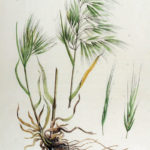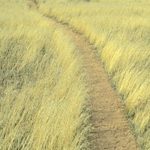 Cheatgrass is an innocuous-looking plant you’ll encounter everywhere in the Great Basin. At higher elevations, it’s a wispy, occasional presence filling in the spaces between patches of sagebrush. But in the wide valleys between the mountains it reigns supreme, rolling out golden meadows that stretch as far as the eye can see.
Cheatgrass is an innocuous-looking plant you’ll encounter everywhere in the Great Basin. At higher elevations, it’s a wispy, occasional presence filling in the spaces between patches of sagebrush. But in the wide valleys between the mountains it reigns supreme, rolling out golden meadows that stretch as far as the eye can see.
Yesterday, I drove the hundred eighteen miles from Battle Mountain south to Austin, Nevada. Why? Because Austin (elevation 6,575, population 192) boasts its self-proclaimed status as the most isolated town in the lower forty-eight states. And indeed, a hundred miles, more or less, separates it from the closest towns at each of the cardinal points of the compass. In almost all that distance, I saw only an endless expanse of cheatgrass filling the wide valleys bisected by the gravel road I traveled. From inside the car on such a brilliant, blue-sky day, it looked beautiful, not unlike the proverbial amber waves of grain nodding in a lively breeze sweeping the valley. But I wasn’t fooled.
Cheatgrass is anything but a welcome ground cover. It sprouts early in the year, sucking up all the moisture before browning out in early summer. In the process, it drives out the native grasses and forms vast, sterile monocultural deserts where little wildlife can survive, or livestock thrive.
Long before the monsoon rains of late summer arrive, these savannahs turn bone-dry, becoming fire hazards that ignite like a match at the touch of any random lighting strike. By the end of the modest thunderstorm I drove through on my way to Austin, I could make out five range fires spewing angry clouds of roiling, opalescent smoke skywards.
Encountered in person, cheatgrass is best understood in religious terms. If you are a Christian, think hair shirts and the mortification of the flesh by hermitic monks. If you are a Shiite, recall self-flagellation to commemorate the martyrdom of Husayn ibn Ali. If Buddhism is your creed, then cheatgrass is the very personification of Karma at work, since cheatgrass is an over-achieving invasive species of no discernible value that seized control after over-grazing left traditional grasslands vulnerable to usurpation.
Cheatgrass does not overtly resemble an infernal invention of the devil, but if there is a Satan, then cheatgrass is his work at its diabolical best: its simple design is excruciatingly effective at invoking words that must bring a smile to the Dark Lord’s lips.
To be more specific, a stem of cheatgrass looks much like a stunted stalk of wheat, culminating in a sparse spray of seeds, each with a fine strand at its end. If you look closely, you’ll discover that each seed ends in a tiny but wicked barb. Its purpose, as with many other types of seeds, is to attach itself to a passing animal (such as you), able to carry it to an appropriate place to germinate and perpetuate the species.
But these harmless-appearing ovules possess several unique characteristics that outclass the most noxious features of other barbed plant seeds, like cockleburs. True, cockleburs exhibit an almost magnetic attraction to the ears of cocker spaniels and possess a dervish-like power to twirl themselves into impenetrable cocoons of dog hair. But most hitchhiking seeds with an affinity for long-haired dogs and wool hiking socks generally travel peacefully and surrender gracefully when detected.
 Not so with cheatgrass. It has achieved an almost parasitic ability to burrow, not unlike a shipworm, in a direction parallel to, rather than into, the surface of its victim. Once the slender shaft of a seed threads (and hides) itself between the inner and the outer layer of your sock, it works its sharp and painful tip deep into the tender flesh of your ankle.
Not so with cheatgrass. It has achieved an almost parasitic ability to burrow, not unlike a shipworm, in a direction parallel to, rather than into, the surface of its victim. Once the slender shaft of a seed threads (and hides) itself between the inner and the outer layer of your sock, it works its sharp and painful tip deep into the tender flesh of your ankle.
Cheatgrass is insidious as well as diabolical. Even a short walk leaves your ankles a-fuzz with the tips of embedded cheatgrass seeds and afire with their mischief. Nothing to do then but sit down, take off your shoes and socks, turn the latter inside out and pluck your adversaries out one by one. And yet – and yet – when you lace up and resume your trek again, you will always find that the one seed that was making you most miserable is still there and hard at work.
The malign spirit of cheatgrass will also follow you home. Invariably there will be a few seeds still lurking in your socks like members of an Al Qaeda terror sleeper cell. Even after wearing those hose many times, some mysterious signal will activate one of these tiny terrorists, inspiring it to grimly emerge and gleefully implant itself in your ankle with evil zeal.
All in all, burning your socks after a trip to the Southwest is not an unreasonable idea. Besides protecting your ankles from further attack, the act might provide a certain catharsis, particularly if you believe, as some do, that plants have senses, perhaps (in this case) even the ability to feel agony equal to your own.
So it is that cowboy boots have a very serious purpose. If you don’t happen to own a pair of such manly footwear, then a cheaper alternative is to purchase a set of gaiters. Outfitters sell them for cross-country skiing to keep snow from accumulating on, and melting into, your lower legs. But they’re tough enough to foil cheatgrass as well. Basically, gaiters are an ankle wrap, with Velcro or snaps where their edges meet and a bit of bungee cord to pass under your boot ahead of the heel to prevent the sheath from hiking upwards, leaving your vulnerable legs defenseless.
I highly recommend you purchase a pair of gaiters if you plan to hike in the Southwest. In a pinch, aluminum foil and duct tape can provide equal, if somewhat bizarre looking, protection. That is, unless you’ve personally been guilty of introducing an invasive, foreign species. If that’s the case, you’ve got some serious atonement to do, and cheatgrass would serve that purpose nicely.
August 26, 2005
You can find the first post in this series here
If you’d like to read future posts in this series, be sure to provide your email address in the upper right corner of this page and check the “Email notice of blog entries” box

Follow Us!